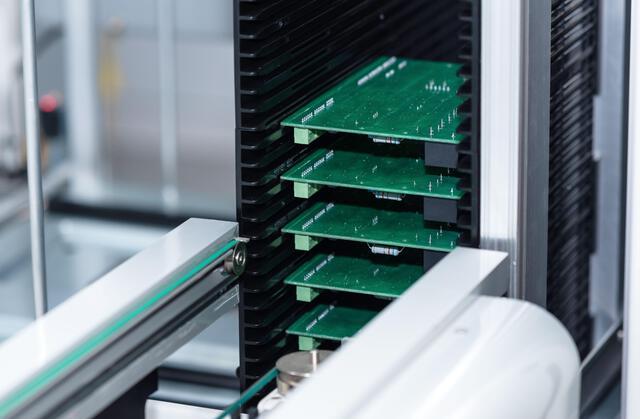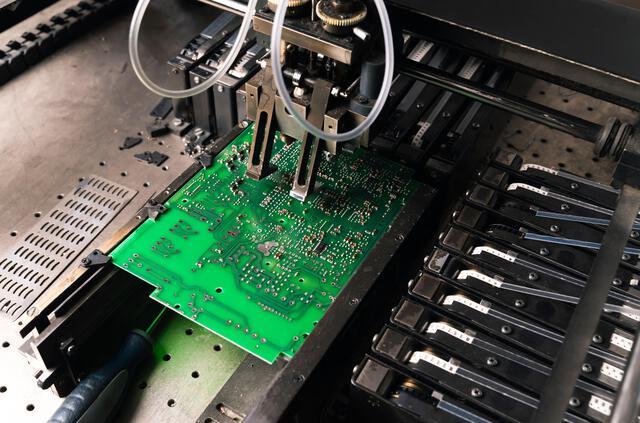Content Menu
● Understanding SMT Lines and Their Components
● The Role of PCB Conveyors in SMT Lines
● Benefits of Using PCB Conveyors
● Types of PCB Conveyors Used in SMT Lines
● Best Practices for Reducing Downtime with PCB Conveyors
● Conclusion
● FAQ
>> 1. What is an SMT line?
>> 2. How do PCB conveyors work?
>> 3. What are the benefits of using automated conveyors in manufacturing?
>> 4. What types of conveyors are commonly used in SMT lines?
>> 5. How can manufacturers ensure their conveyor systems operate efficiently?
● Citations:
In the fast-paced world of electronics manufacturing, minimizing downtime is crucial for maintaining productivity and profitability. Surface Mount Technology (SMT) lines utilize various automated systems, including PCB conveyors, to streamline the production process. This article explores how SMT line PCB conveyors can significantly reduce downtime in PCB manufacturing, enhancing efficiency and ensuring high-quality outputs.

Understanding SMT Lines and Their Components
SMT lines are designed for the assembly of electronic components onto printed circuit boards (PCBs). The process involves several stages, including:
- Solder Paste Printing: Applying solder paste to designated areas on the PCB.
- Component Placement: Using pick-and-place machines to position components accurately on the soldered areas.
- Reflow Soldering: Heating the assembled boards to melt the solder paste, creating secure connections.
- Inspection: Utilizing automated optical inspection (AOI) systems to check for defects.
Each of these stages relies heavily on efficient material handling systems, particularly conveyor systems, to ensure a smooth workflow.
The Role of PCB Conveyors in SMT Lines
PCB conveyors are integral to SMT lines, serving multiple functions that contribute to reduced downtime:
- Continuous Movement: Conveyors facilitate the continuous movement of PCBs between different stages of the assembly line. This eliminates delays associated with manual handling and ensures that production flows seamlessly from one operation to the next.
- Minimized Bottlenecks: By maintaining a steady pace and reducing waiting times at each station, conveyors help prevent bottlenecks that can cause significant downtime. They ensure that each machine operates at its optimal speed without interruption.
- Automated Handling: Automation reduces the need for manual labor, which is often a source of errors and delays. With conveyors, PCBs are transported automatically, minimizing human intervention and allowing operators to focus on more critical tasks.
Benefits of Using PCB Conveyors
The implementation of PCB conveyors in SMT lines offers several advantages that directly contribute to reduced downtime:
1. Increased Throughput: With conveyors moving PCBs efficiently through each stage, manufacturers can achieve higher throughput rates. This means more products can be completed in less time, ultimately leading to increased production capacity.
2. Improved Quality Control: Automated systems reduce the likelihood of human error during handling. This leads to fewer defects and rework, which are common causes of downtime in manufacturing processes.
3. Enhanced Safety: Manual handling poses safety risks such as accidents or damage to PCBs. Conveyors provide a safer alternative by minimizing physical interaction with PCBs during transport.
4. Flexibility and Adaptability: Modern conveyor systems can be configured to accommodate different types of PCBs and production requirements. This adaptability allows manufacturers to respond quickly to changing demands without significant downtime for reconfiguration.
5. Reduced Maintenance Needs: Well-designed conveyor systems require less frequent maintenance compared to manual handling processes. Regular maintenance checks can further enhance reliability and minimize unexpected breakdowns.

Types of PCB Conveyors Used in SMT Lines
There are various types of conveyors used in SMT lines, each designed for specific functions:
- Belt Conveyors: These are commonly used for transporting PCBs between machines. They offer flexibility and can be customized for different layouts.
- Slat Chain Conveyors: Ideal for transporting heavier or larger boards, slat chain conveyors provide stability and precision during movement.
- Buffer Conveyors: These conveyors temporarily hold PCBs between processes, preventing bottlenecks and allowing downstream operations to continue without interruption.
- Inspection Conveyors: Equipped with inspection stations, these conveyors allow operators to monitor quality while moving PCBs through the assembly line.
Best Practices for Reducing Downtime with PCB Conveyors
To maximize the efficiency of PCB conveyors in reducing downtime, manufacturers should consider implementing the following best practices:
1. Regular Maintenance Checks: Conduct routine inspections and maintenance on conveyor systems to identify potential issues before they lead to breakdowns.
2. Employee Training: Ensure that staff are well-trained in operating conveyor systems and understanding their significance in minimizing downtime.
3. Integration with Other Systems: Seamlessly integrate conveyor systems with other equipment in the SMT line, such as pick-and-place machines and reflow ovens, to create a cohesive workflow.
4. Data Monitoring and Analytics: Utilize data analytics tools to monitor conveyor performance and identify areas for improvement. This proactive approach can help address issues before they escalate into significant problems.
5. Investing in Quality Equipment: Choose high-quality conveyor systems designed for durability and reliability. Investing in robust equipment can lead to long-term savings by reducing maintenance costs and downtime.
Conclusion
In conclusion, SMT line PCB conveyors play a vital role in reducing downtime within PCB manufacturing processes. By facilitating continuous movement, minimizing bottlenecks, automating handling procedures, and improving overall efficiency, these systems contribute significantly to enhanced productivity and quality control. As manufacturers continue to seek ways to optimize their operations, investing in advanced conveyor technology will remain a key strategy for success in the competitive electronics industry.

FAQ
1. What is an SMT line?
An SMT line is a series of automated processes used for assembling electronic components onto printed circuit boards (PCBs) using surface mount technology (SMT).
2. How do PCB conveyors work?
PCB conveyors transport printed circuit boards between different stages of the assembly process automatically, ensuring continuous movement without manual handling.
3. What are the benefits of using automated conveyors in manufacturing?
Automated conveyors increase throughput, improve quality control by reducing human errors, enhance safety by minimizing manual handling risks, and lower maintenance needs compared to manual processes.
4. What types of conveyors are commonly used in SMT lines?
Common types include belt conveyors, slat chain conveyors for heavier boards, buffer conveyors for temporary storage between processes, and inspection conveyors equipped with monitoring stations.
5. How can manufacturers ensure their conveyor systems operate efficiently?
Manufacturers can ensure efficient operation by conducting regular maintenance checks, training employees on proper use, integrating systems seamlessly with other machinery, utilizing data monitoring tools, and investing in high-quality equipment.
Citations:
[1] https://www.zjyingxing.com/info/what-is-the-effect-of-conveyor-on-smt-machines-81798016.html
[2] https://www.zjyingxing.com/info/what-does-conveyor-do-in-the-smt-line-96523854.html
[3] https://www.hayawin.com/product-shuttle-conveyor.html
[4] https://www.pcbasic.com/blog/smt_production_line.html
[5] https://www.chuxin-smt.com/why-sm-pcb-conveyors-boost-smt-efficiency/
[6] https://www.smtfactory.com/How-do-you-handle-PCBs-in-SMT-Production-Line-id49155647.html
[7] https://www.redlinesystems.com/4-ways-you-can-reduce-belt-conveyor-downtime/
[8] https://www.smtmanufacturing.net/what-are-the-primary-benefits-of-the-use-of-smt/
[9] https://www.hayawin.com/news-how-do-you-handle-pcbs-in-smt-production-line.html
[10] https://www.smtfactory.com/Introduction-of-types-of-SMT-conveyor-id60011807.html
[11] https://www.onesmt.com/5-advantages-to-using-smt/
[12] https://circuitsassembly.com/ca/magazine/24903-oven-profiling-1505.html
[13] https://www.jrpanel.com/engineerhome/keyword/JRPanel_Maintenance_of_Surface_Mount_Technology_SMT_Equipm.html
[14] https://www.smtneoden.com/news/how-to-effectively-improve-the-production-efficiency-of-pcb-smt-machine/
[15] https://www.wevolver.com/article/smt-process
[16] https://www.smtfactory.com/Optimizing-SMT-Manufacturing-The-Crucial-Impact-of-PCB-Handling-Machines-id41104497.html
[17] https://www.smtfactory.com/Mastering-Surface-Mount-Technology-SMT-Workflows-id41117676.html
[18] https://www.hayawin.com/news-5-advantages-to-using-smt-in-your-electronic-manufacturing-project.html
[19] https://www.party.biz/blogs/153971/338665/smt-pcb-buffer-vs-conveyors-which-is-better-for-your-assembly?c=22
[20] https://ventureoutsource.com/contract-manufacturing/printed-circuit-board-surface-mount-technology-SMT-line-productivity-preventative-maintenance-cause-effect-analysis
[21] https://www.smtfactory.com/Introduction-of-types-of-SMT-conveyor-id60011807.html
[22] https://hawkerrichardson.com.au/blog/win-with-smt-preventative-maintenance/
[23] https://m.smt11.com/solution/Consumer-Electronics/Exploring-the-Benefits-of-SMT-Production-Line-and-DIP-Line-in-Power-Supply-PCBA-Manufacturing-56.html
[24] https://smtnet.com/news/index.cfm?fuseaction=view_news&company_id=58069&news_id=30605
[25] https://www.smthelp.com/pcb-conveyor-for-smt-assembly-production-line.html
[26] https://fancort.com/pages/smt-material-handling-conveyors
[27] https://www.linkedin.com/pulse/how-do-you-handle-pcbs-smt-production-line-pickandplacemachine
[28] https://develop-llc.com/insights/guide-to-pcb-assembly-automation/
[29] https://www.hayawin.com/news-introduction-of-types-of-smt-conveyor.html
[30] https://www.zjyingxing.com/info/what-does-conveyor-do-in-the-smt-line-96523854.html
[31] https://www.allsmt.com/High-End-PCB-Conveyor
[32] https://www.pnconline.com/blog/layouts-of-smt-assembly-line/
[33] https://www.morequip.com/products/pcb-conveyor.html
[34] https://www.ascen.ltd/Blog/machine/PCB_conveyor/466.html
[35] https://www.anzer-usa.com/resources/conveyors-and-handling-systems/
[36] https://www.linkedin.com/pulse/rapid-smt-assembly-improving-efficiency-surface-oerzc
[37] https://fancort.com/pages/material-handling-equipment
[38] https://www.smtfactory.com/pcb-handling-machine.html
[39] https://www.pcbasic.com/blog/smt_production_line.html
[40] https://www.cisco-eagle.com/blog/2015/05/26/conveyor-maintenance-tips-to-reduce-downtime-missed-deadlines-headaches/
[41] https://www.smtmanufacturing.net/what-is-smt-a-comprehensive-guide-to-smt-line-equipment/
[42] https://www.sunzontech.com/product/pcb-guide-conveyor-for-smt-production-line-sunzontech/
[43] https://congnghiepviet.com.vn/10-frequently-asked-questions-about-conveyor-systems.htm
[44] https://versae.com/smt-assembly-faq/
[45] https://www.youtube.com/watch?v=tR3s8gTdnmg
[46] https://www.recyclingtoday.com/article/3-ways-to-reduce-conveyor-downtime-metal-recycling/
[47] https://www.manncorp.com/collections/smt-conveyors-pcb-handling
[48] https://stoutconveyors.com/conveyor-maintenance-tips-to-prevent-downtime-keep-your-operations-running-smoothly/
[49] https://jhdpcb.com/blog/smt-manufacturing-technology/
[50] https://core-emt.com/board-handling
[51] https://www.smartmachine.com/microbreweries/brewery-faq/




















